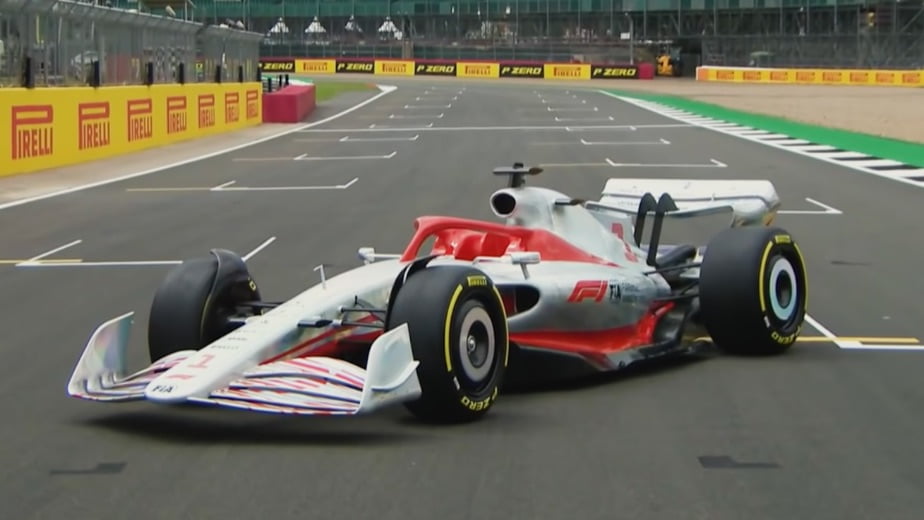The FIA has released a prototype car with the refreshed rules and regulations pertaining to the car design for 2022. The new design has been made to pack the grid closer together in order to make the racing easier and better than ever.
Formula 1 cars act as the opposite of an aeroplane, meaning while the body of an aeroplane has been designed to lift off, the body of an F1 car does the opposite. It sticks closer to the track and makes it faster around the corners and turns. This impact is called down force. It has been hypothesized that a Formula 1 car can drive upside down in a tunnel going at about 130 KMPH.
The current chassis design also makes it harder for anyone to follow it, which means it makes it hard to get close and overtake. The body of the car disturbs the air and makes it ‘dirty’ for the car immediately after, to navigate it in the same way as the one before. The new design has been introduced to eliminate all that, so as to promote more ontrack battles while also maintaining the down force. The 2021 prototype achieves that by smoothening most of the body work and moving a lot of the aerodynamic features to the bottom of the car, so as to keep the air as clean and undisturbed as possible.
The front and rear wings of the car have a different shape when compared to that of now, because the new ones are meant to direct the air flow up and out of the way for the car following, instead of aiming it straight at them. The current stepped floor, in the 2022 automobile will have fully formed underfloor tubes. This change in floor form will allow the teams to generate substantial quantities of downforce via ground effect — downforce that will be less affected when following another car – while also producing less disruptive airflow for the car in front.
Pirelli has also changed the dimensions of their tyre by increasing their diameter from 660 millimetres to 720 millimetres. Big tyres are usually associated with more horsepower but, when it comes to professional race cars the aim is to keep them as light as possible. Every racing team in all motorsports are very aware of the weight they add to their car when they make even the smallest changes. Even the amount of fuel they use for any race is determined after having carefully calculated the minimum amount they would need.
The technical director of the Mercedes F1 team, James Allison has come out and said that the bigger tyres will make the cars slower by 2 seconds per lap which is huge. Having bigger tyres will not only increase the weight or the cars, they'll also require higher rotational mass. Rotational mass of an object is a description of how easy or difficult it is to rotate a body, or to stop it once it is rotating, it depends on where the mass weight has been placed on the object and the closer it is to the center the easier it is to move. On the bigger tyres the weight will be placed further from the center and so, its rotational mass will be higher which would imply fewer rotations leading to slower speed.
The new tyre regulations will also decrease the thickness of the rubber on the wheels, which would mean that they would decrease the amount of bumps and shocks that the wheels absorb for the car. The decreased suspension would require the engineers to add more parts to the car to support the wheels to make for a smoother drive, which would further add weight to the car and slow it down. Formula One is not alone in making the switch to bigger tyres for the future, Indycar and NASCAR are planning it too.
Also read: Merc ‘manifests’ Verstappen DNF into existence
There is a reason why these motorsports are willing to reduce the speeds of the race cars. Turns out thick tyres are the one of the biggest contributors to the dirty air the cars leave behind. The surface of the tyre oscillates while turning and the thicker the rubber the more dirty air is left behind. 2022 cars will reduce the rubber width and also the down force so that the tyres can support the car. This will allow the tyres to be run on lower pressure which will lead to fewer tyre blow outs during races like the two in Baku this year. If that isn't enough to keep the air clean FIA has also added the requirement of winglets that sit above the tyre to keep the air flow undisturbed for the car following.
The minimum weight requirement of the car has been increased by 5% to incorporate the increased weight of the four wheels and tyres which weigh roughly 14kg more than they did in 2021. Most fans would agree that the price is worth paying, given that the new tyres have been intended to be less prone to overheating, among other things. The weight of the car has also been affected by higher safety criteria, with crash test magnitudes being increased to guarantee drivers are better protected than ever before.
Overall we can look forward to next year’s racing as all the teams will have to redesign their cars to fit the new regulations and it will be hard to predict who comes out with the fastest car. These regulations that were meant to come about in 2021 were postponed due to the pandemic. We can expect more intense racing and a higher chances for overtake which will only add to the race excitement.













